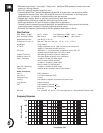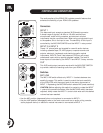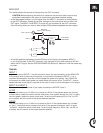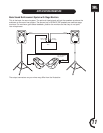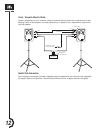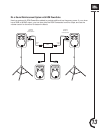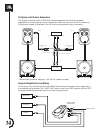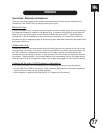
Indicators
PEAK
The PEAK LED (Light Emitting Diode) illuminates to indicate that the system is approaching
clipping. The threshold for this light is actually about 2 dB below clipping. An occasional
flickering of this light on the loudest peaks is acceptable. If this LED is on for more than the
duration of brief dynamic peaks, the system is being overdriven. Continuously over-driving
the system will result in unpleasant and fatiguing distortion and may lead to premature failure
of your speaker system.
If the PEAK LED illuminates excessively:
• Reduce INPUT 1, 2, and 3.
• Reduce the output level of the mixer, musical instrument, or other source connected to
the speaker.
• If there is a great deal of LF EQ or HF EQ boost, return the controls to the “flat” (centered)
position.
SIGNAL
Illuminates to indicate a usable signal from INPUT 1.
MIC
This LED lights to indicate that the MIC/LINE switch is in the MIC (depressed) position.
VOLTAGE SELECTION AND FUSES
Changing Voltage
Your EON15-G2 will typically be set at the factory to accommodate the power mains voltage
in your area. Before you set up your EON15-G2 for the first time it is a good idea to verify that
the setting of the selector is appropriate for the power in your area. In the event that you do
need to change the voltage:
• Make sure that the speaker is powered off and the AC is disconnected from the speaker.
• Directly below the male IEC connector on the speaker is a voltage selector. Break the
factory-applied seal and slide the switch to the appropriate setting.
• Set the voltage selector switch to the 115V or 230V setting as required for your area.
• After having reconfirmed that the correct voltage is selected, reconnect the AC (IEC connector)
and power the unit up.
DO NOT UNDER ANY CIRCUMSTANCES OPERATE THE UNIT WITH THE WRONG VOLTAGE
SELECTED. DOING SO MAY RESULT IN SERIOUS DAMAGE TO YOUR SPEAKER SYSTEM
WHICH WILL NOT BE COVERED BY WARRANTY.
Fuse Replacement
The EON15 G2 has no user-serviceable fuses. Failure of fuses is most frequently a symptom
of problems requiring service by a competent technician.
10







